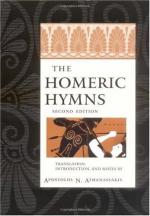Among the Pawnees, not a mother and daughter, but two primal beings, brothers, named Manabozho and Chibiabos, are the chief characters. The Manitos (spirits or gods) drown Chibiabos. Manabozho mourns and smears his face with black, as Demeter wears black raiment. He laments Chibiabos ceaselessly till the Manitos propitiate him with gifts and ceremonies. They offer to him a cup, like the beverage prepared for Demeter, in the Hymn, by Iambe. He drinks it, is glad, washes off the black stain of mourning, and is himself again, while Earth again is joyous. The Manitos restore Chibiabos to life; but, having once died, he may not enter the temple, or “Medicine Lodge.” He is sent to reign over the souls of the departed as does Persephone. Manabozho makes offerings to Mesukkumikokwi, the “Earth Mother” of the Pawnees. The story is enacted in the sacred dances of the Pawnees. {69}
The Pawnee ideas have fallen, with singularly accurate coincidence, into the same lines as those of early Greece. Some moderns, such as M. Foucart, have revived the opinion of Herodotus, that the Mysteries were brought from Greece to Egypt. But, as the Pawnee example shows, similar natural phenomena may anywhere beget similar myths and rites. In Greece the donnee was a nature myth, and a ritual in which it was enacted. That ritual was a form of sympathetic magic, and the myth explained the performances. The refinement and charm of the legend (on which Homer, as we saw, does not touch) is due to the unique genius of Greece. Demeter became the deity most familiar to the people, nearest to their hearts and endowed with most temples; every farm possessing her rural shrine. But the Chthonian, or funereal, aspect of Chibiabos, or of Persephone, is due to a mood very distinct from that which sacrifices pigs as embodiments of the Corn Spirit, if that be the real origin of the practice.
We should much misconceive the religious spirit of the Greek rite if we undertook to develop it all out an origin in sympathetic magic: which, of course, I do not understand Mr. Frazer to do. Greek scholars, again, are apt to view these researches into savage or barbaric origins with great distaste and disfavour. This is not a scientific frame of mind. In the absence of such researches other purely fanciful origins have been invented by scholars, ancient or modern. It is necessary to return to the pedestrian facts, if merely in order to demonstrate the futility of the fancies. The result is in no way discreditable to Greece. Beginning, like other peoples, with the vague unrealised conception of the Corn Mother (an idea which could not occur before the agricultural stage of civilisation), the Greeks refined and elevated the idea into the Demeter of the Hymn, and of the Cnidian statue. To do this was the result of their unique gifts as a race. Meanwhile the other notion of a Ruler of Souls, in Greece attached to Persephone, is found among peoples not yet agricultural: nomads living on grubs, roots, seeds of wild grasses, and the products of the chase. Almost all men’s ideas are as old as mankind, so far as we know mankind.




